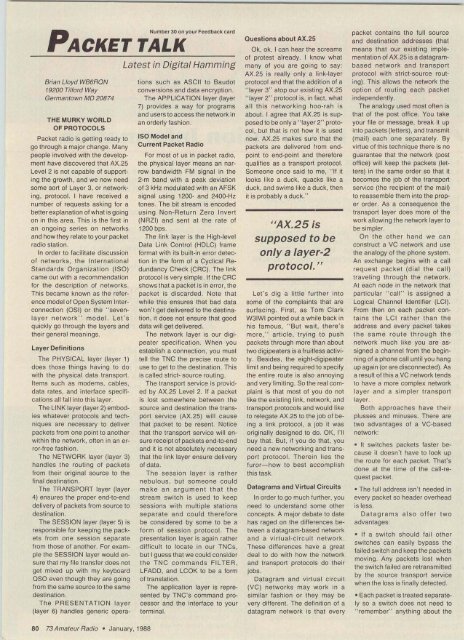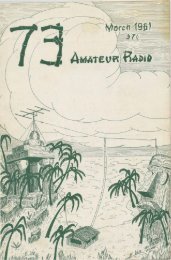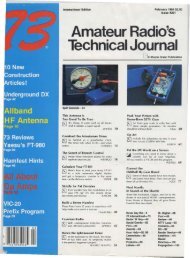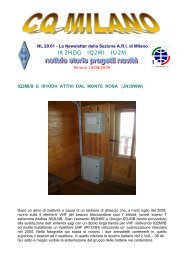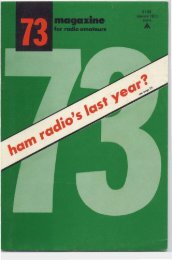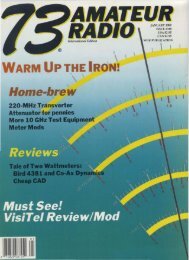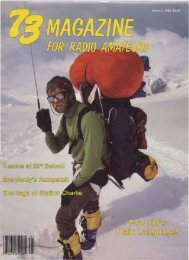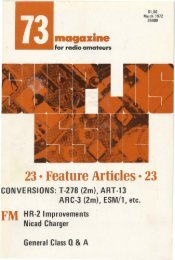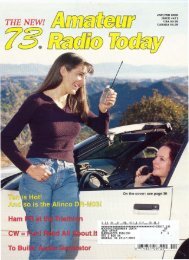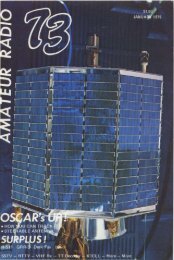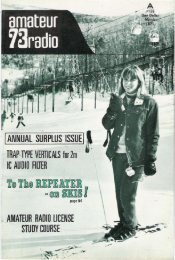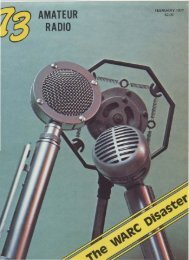You also want an ePaper? Increase the reach of your titles
YUMPU automatically turns print PDFs into web optimized ePapers that Google loves.
PACKET TA'L'ii"''''''''''''''<br />
Brian Lloyd WB6RON<br />
19200 Tilford Way<br />
Germantown MD 20874<br />
THE MURKY WORLD<br />
OF PROTOCOLS<br />
Packet radio is gellmg ready to<br />
go through a major change. Many<br />
people involved wi th the development<br />
have discovered that AX.25<br />
level 2 is not capable of supporting<br />
the growth , and we now need<br />
same sort of Layer 3, or networking,<br />
protocol. I have received a<br />
number of requests asking for a<br />
better explanation of what is going<br />
on in this area. This is the first in<br />
an ongoing series on networks<br />
and how they relate to your packet<br />
radio statio n.<br />
In order to facilitate discussion<br />
of networks, the Inte rnationa l<br />
Standards Organiza tion (ISO)<br />
came out with a recommendation<br />
for the description of networks .<br />
This became known as the reference<br />
model of Open System Interconnection<br />
(OSI) or the "sevenlayer<br />
network" model , Let's<br />
quickly go through the layers and<br />
their general meanings.<br />
Layer Definitions<br />
The PHYSICAL layer (layer 1)<br />
does those things having to do<br />
with the physical data transport.<br />
Items such as modem s, cables ,<br />
data rates. and interface specif ications<br />
all fall into this layer.<br />
The LINK layer (layer 2) embodies<br />
whatever protocols and techniques<br />
are necessary to deliver<br />
packets from one point to another<br />
within the network, often in an error-free<br />
fashion .<br />
The NETWORK layer (layer 3)<br />
handles the routing ot packets<br />
from their original source to the<br />
final destination.<br />
The TRANSPORT layer (tayer<br />
4) ensures the proper end-to-end<br />
delivery of packets from source to<br />
destination .<br />
The SESSION layer (layer 5) is<br />
responsible lor keeping the packets<br />
from one session separate<br />
from those of another. For exampie<br />
the SESSION layer would ensure<br />
that my file transfer does not<br />
get mixed up with my keyboard<br />
aso even Ihough they are going<br />
from the same source to the same<br />
destination.<br />
The PR ES ENTATION layer<br />
(layer 6) handles generic opera-<br />
80 73Amaleur<strong>Radio</strong> · January, 1988<br />
Latest in Digital Hamming<br />
nons such as ASCII 10 Baudot<br />
conversions and data encryption.<br />
The APPLICATION layer (layer<br />
7) provides a way for programs<br />
and users to access the network in<br />
an orderly fashion.<br />
ISO Model and<br />
Current Packet <strong>Radio</strong><br />
For most of us in packet radio,<br />
the physical layer means an narrow<br />
bandwidth FM signal in the<br />
2-m band with a peak deviation<br />
of 3 kHz modulated with an AFSK<br />
signal using 1200· and 2400-Hz<br />
tones. The bit stream is encoded<br />
using Non-Return Zero Invert<br />
(NRZI) and sent at the rate of<br />
1200 bps.<br />
The linl( layer is the High-level<br />
Data Link Control (HOLG) frame<br />
format with its built-in error detection<br />
in the form of a Cyclical Redundancy<br />
Check (CRG). The link<br />
protocol is very simple. II the CRC<br />
shows that a packet is in error, the<br />
packet is discarded. Note that<br />
while this ensures that bad data<br />
won't get delivered to the destination,<br />
it does not ensure that good<br />
data will get delivered.<br />
The network layer is our digipeat<br />
er specification, When you<br />
establish a connection, you must<br />
tell the TNC the precise route 10<br />
use to get to the destination . This<br />
is called strict- source routing .<br />
The transport service is provided<br />
by AX.25 Level 2. If a packet<br />
is lost somewhere between the<br />
source and destination the transport<br />
service (AX.25) will cause<br />
that packet to be resent. Notice<br />
that the transport service will ensure<br />
receipt of packets end-to-end<br />
and it is not absolutely necessary<br />
that the link layer ensure delivery<br />
of data ,<br />
Th e session layer is ra th er<br />
nebulous, but someone could<br />
make an argument t hat the<br />
stream switch is used to keep<br />
sessions with multiple stations<br />
separate and could therefore<br />
be considered by some to be a<br />
fo rm of session protocol. The<br />
presentation layer is again rather<br />
difficult to locate in our TNCs,<br />
but I guess that we could consider<br />
the TNC commands FI LTER,<br />
LFAOO, and LCOK to be a form<br />
of translation.<br />
The application layer is represented<br />
by TNC's command processor<br />
and the interface to your<br />
terminal.<br />
Questions about AX _25<br />
Ok, ok, , can hear the screams<br />
of protest alrea dy. I know what<br />
many of you are going to say:<br />
AX.25 is really only a link-layer<br />
protocol and that the addition of a<br />
"layer 3" atop our existing AX.25<br />
"layer 2" protocol is, in fact , what<br />
all this networking hoo-rah is<br />
about. I agree that AX.25 is supposed<br />
to be only a "layer 2" protocol,<br />
but that is not how it is used<br />
now. AX.25 makes sure that the<br />
packets are delivered from endpoint<br />
to end-point and therefore<br />
qualifies as a transport protocol.<br />
Someone once said to me, " If it<br />
looks like a duck, quacks like a<br />
duck, and swims like a duck, then<br />
it is probably a duck ."<br />
"AX.25 is<br />
supposed to be<br />
only a layer-2<br />
protocol. rr<br />
Let's dig a tune further into<br />
some of the complaints that are<br />
surfacing. First, as Tom Clark<br />
W31WI pointed out a while back in<br />
his famous , "But wait, there's<br />
more, " ar ticle, trying to push<br />
packets throu gh more than about<br />
two digipeaters is a fruitless activity.<br />
Besides , the eight-digipeater<br />
limit and being required to specify<br />
the entire route is also annoying<br />
and very limiting. So the real complaint<br />
is that most of you do not<br />
like the existing link, network, and<br />
transport protocols and would like<br />
to relegate AX,25 to the job of being<br />
a link protocol, a job it was<br />
originally designed to do. Or; I'll<br />
buy that. But, it you do that, you<br />
need a new networking and transport<br />
protocol. Therein lies the<br />
furor-how to best accompusn<br />
this task.<br />
Datagrams and Virtual Circuits<br />
In order to go much further, you<br />
need to understand some other<br />
concepts. A major debate to date<br />
has raged on the differences between<br />
a datagram-based network<br />
and a virtual-circuit network ,<br />
These differences have a great<br />
deal to do with how the network<br />
and transport protocols do their<br />
jobs.<br />
Datagram and virtual circuit<br />
(VC) netwo rks may work in a<br />
sim ilar fashion or they may be<br />
very different. The definition of a<br />
datagram network is that every<br />
packet contains the tun source<br />
and destination addresses (that<br />
means that our existing implementation<br />
ofAX.25 is a datagram.<br />
based network and transport<br />
protocol with strict-source routing).<br />
This allows the network the<br />
option of routing each packet<br />
independently.<br />
The analogy used most often is<br />
that of the post office. You take<br />
your tile or message , break it up<br />
into packets (letters), and transmit<br />
(mail) each one separately. By<br />
virtue of this technique there is no<br />
guarantee that the network (post<br />
office) will keep the packets (letters)<br />
in the same order so that it<br />
becomes the job of the transport<br />
service (the recipient of the mail)<br />
to reassemble them into the proper<br />
order. As a consequence the<br />
transport layer does more of the<br />
work allowing the network layer to<br />
be simpler.<br />
On the other hand we c an<br />
construct a VC network and use<br />
the analogy ot the phone system.<br />
An exchange begins with a call<br />
request packet (dial the call)<br />
traveling through the netwo rk.<br />
At each node in the network that<br />
particular " call " is assigned a<br />
Logical Channel Identifier (LCI).<br />
From then on each packet ccntains<br />
the Lei rather than the<br />
address and every packet takes<br />
th e same route th roug h th e<br />
network much like you are assigned<br />
a channel from the beginning<br />
of a phone call until you hang<br />
up again (or are disconnected) . As<br />
a result of this a VC network tends<br />
to have a more complex network<br />
layer and a simpler transport<br />
layer.<br />
Both approaches have their<br />
cresses and minuses . There are<br />
two advantages of a vc-baeeo<br />
network:<br />
• It switches packets faster because<br />
it doesn't have to look up<br />
the route for each packet. That's<br />
done at the time of the cali-request<br />
packet.<br />
• The full address isn't needed in<br />
every packet so header overhead<br />
is less.<br />
Datagrams also offer two<br />
advantages:<br />
• If a switch should fail other<br />
switches can easily bypass the<br />
failed switch and keep the packets<br />
moving. Any packets lost when<br />
the switch failed are retransmitted<br />
by the source transport service<br />
when the loss is finally detected.<br />
• Each packet is treated separately<br />
so a switch does not need to<br />
" remember" anything about the


